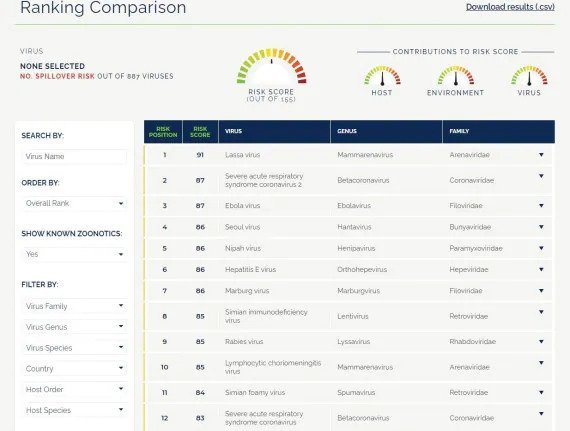An App That Ranks the Most Dangerous Viruses
An open source platform draws up a constantly updated ranking of the viruses most at risk of making a leap of species and passing to man.

Credits
Under what conditions do certain animal viruses make the leap from species to man? What are the most dangerous pathogens in this sense, and what behaviors could we implement (or abandon!) To defend ourselves from future pandemics? The answers to these questions require a collective effort of analysis: with this goal was born SpillOver , an interactive online platform that collects and compares data on recently discovered viruses and puts them in order of risk. In the first positions of the list are the pathogens to which to pay more attention, because they are more at risk of passing from animals to humans.
SCIENTIFIC REFERENCES
The tool was developed by a group of experts from the University of Davis, California, coordinated by ecologist Zoë Grange and epidemiologist Jonna Mazet. The main contribution to the work is found in a scientific study published in PNAS which identifies the main risk factors (linked to the characteristics of viruses or their animal reservoirs, but also to environmental dynamics, such as human behavior) that facilitate the jump of species.
Using data from more than 500,000 samples taken from more than 74,000 animals in various parts of the world, the team was able to establish the potential spillover risk of 887 animal viruses. Much information comes from the project on emerging pandemics PREDICT , conducted by the Californian university from 2009 to 2020.
HOW THE APP WORKS
The score that determines the spillover potential of viruses is calculated on the basis of 32 animal, viral or human risk factors that could facilitate the passage of species and human infection. The site considers viruses from 25 different families, from coronaviruses to the one to which the Ebola virus belongs . Users can consult the list by filtering by type of virus, by geographic area or by animal-reservoir, while professionals can add information on newly discovered viruses to the database.

To confirm the validity of this tool is the fact that in the first 12 positions (see image above ) there are already zoonotic viruses, i.e. viruses of animal origin that have already attacked humans. Despite the devastation created, SARS-CoV-2 is "only" in second position, between the Lassa virus (which gives rise to a hemorrhagic fever) and the Ebola virus. This is because, the researchers explain, the site assesses the risk of another potential future spillover, regardless of what has already happened; and also because the SARS-CoV-2 species jump still lacks key information ( such as identikit and distribution of the host animal ).
THOUSANDS OF ANIMAL VIRUSES
The coronavirus family is however very well represented in the high end of the ranking: many recently discovered coronaviruses are considered more at risk of spillover than other pathogens whose zoonotic potential is already known. A confirmation of the fact that SARS-CoV-2 is only one "that made it" among the many thousands of animal viruses that can also infect humans.